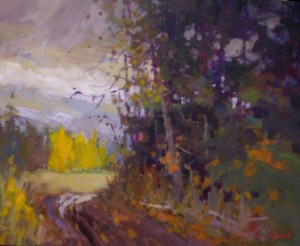Dear Artist,
Not everyone knows what I’m talking about when I drag the word “homeomorphic” out in mixed company. Specifically to do with equality of shapes in differing chemicals, it’s not in the art books. But it’s a valuable creative concept. Without always knowing its name, homeomorphism is generally pointed out as a type of compositional problem. Typically in amateur work, it’s a lineup of equidistant trees, or a mountain that rises up conveniently in order to avoid colliding with a foreground element. It’s a natural tendency of the human mind to automatically organize things neatly and in a regular manner. You can probably see an example of architectural homeomorphism from where you sit — window panes are generally divided from one another by equidistant mullions.
Many artists instinctively fight it. Too much homeomorphism, unimaginatively used, gives a “ruler-regularity” that tends to make work boring. Nature’s not like that. Nature tends to be uneven, random, even chaotic. This means big against small, recession against protrusion, foreground against background, dark against light, warm against cool.
There’s a parallel in music. Music often depends on a regular and reliable rhythmic beat. But in a lot of jazz, reggae and stride piano for example, the beat is given on the off-note. Rather than conformation, there’s counterpoint. While providing a safe haven, homeomorphism tends to snuff natural dynamism and neutralize creative surprise.
But homeomorphism is also a valuable design device. It can add interest, mystery, magic and strength. Lineups, repetition, transfers, rhythm and spottification are some of the tools of abstraction. Free from nature’s reality, the creative eye can decide to “hold” a shape with another, or “confuse” by allowing a shape (or a line) to be drawn to another. Homeomorphism is one way to beguile the eye. The next time you’re dragging a brush and wondering where your stroke might end, remember that you have choices. Your stroke can go to something, veer away from something, fall short, overtake, or bump nicely into the middle of something. It’s an esoteric little business but it’s good to be aware that it exists.
Best regards,
Robert
PS: “I pay close attention to the variety of shapes and sizes, and place the objects so that the lines and edges create a rhythm that guides the viewer’s eye around the image and into the focal point.” (Sergei Forostovskii)
Esoterica: Homeomorphism comes from two Greek words homeos — identical, and morphe — shape. I fret about it every day and I’m willing to discuss it openly. Frankly, it drives me nuts. Some days I’m particularly homeomorphic and I just let go and it works to some advantage. One day my late friend Toni Onley remarked how he wallowed in it.
This letter was originally published as “Creative homeomorphism” on April 19, 2005. You can visit the original letter for descriptions of Homeomorphism in the watercolours of Toni Onley at the bottom of letter.
The Letters: Vol. 1 and 2, narrated by Dave Genn, are now available for download on Amazon, here. Proceeds of sales contribute to the production of The Painter’s Keys.
“Let’s find visual excitement in what nature has to offer.” (Toni Onley)
Featured Workshop
Enjoy five full days of drawing and painting at Mill Road Studio in Port Rexton, NL. Work in the studio overlooking scenic Trinity Bay, and en plein air in the stunning coastal landscape with dramatic cliffs rising up out of the North Atlantic.
The cost is $1250.00 CDN including lunch and all materials.
Sessions run from 9:00 a.m. – 4:00 p.m. each day.
For more information please write szeifman@millroadstudio.com
or phone Stephen Zeifman at 709-464-3907.
Featured Artist
My art represents an artistic journey that has been on-going for more than thirty-five years with help and guidance from many wonderful artists. Now, with years of plein-air painting experience, study and solo exhibitions, I believe that my current work has reached its highest level, reflecting the depth of my absorption in the wonder and beauty of the world around me. I have learned that, as an artist, I will never stop looking for better ways to express my feelings in art and that struggling to more fully understand myself is integral to my painting; a philosophy that was part of every workshop I taught. Still is.










1 Comment
I learned so much with regards to this by copying a Clarence Gagon winter scene.